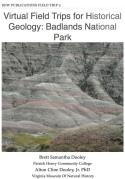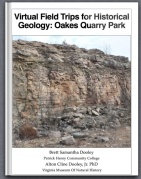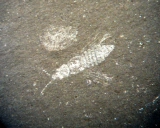 Last Saturday, the Virginia Natural History Society held a symposium at VMNH, “Historical Explorations into Virginia’s Natural History”, with 12 lectures on various aspects of the history of natural history studies in Virginia. I’m not going to detail all of the talks, but I would like to mention one of the highlights from the last lecture of the day, which was presented by Lauck (“Buck”) Ward, Curator Emeritus of Invertebrate Paleontology at VMNH.
Last Saturday, the Virginia Natural History Society held a symposium at VMNH, “Historical Explorations into Virginia’s Natural History”, with 12 lectures on various aspects of the history of natural history studies in Virginia. I’m not going to detail all of the talks, but I would like to mention one of the highlights from the last lecture of the day, which was presented by Lauck (“Buck”) Ward, Curator Emeritus of Invertebrate Paleontology at VMNH.
The image at the top is from “Historiae Conchyliorum, Liber III” by Martin Lister, published in 1687. This was a specimen sent back to Britain from the New World, and was the first New World fossil ever figured and described in a scientific publication. The specimen almost certainly came from Virginia, although Lister mistakenly attributed it to the Virgin Islands (Ward and Blackwelder, 1975). It’s an excellent reproduction of a shell that is common in lower Pliocene deposits in southeastern Virginia (below), even including barnacle scars:
 Incidentally, according to the website “Women’s Work”, the drawings and copperplate engravings for “Historiae Conchyliorum” were produced by Lister’s daughters, Anna and Susanna, who were respectively about 13 and 14 years old at the time.
Incidentally, according to the website “Women’s Work”, the drawings and copperplate engravings for “Historiae Conchyliorum” were produced by Lister’s daughters, Anna and Susanna, who were respectively about 13 and 14 years old at the time.
This species was finally given a binomial name, Pecten jeffersonius (in honor of Thomas Jefferson) by Thomas Say in 1824. Say’s description was based on specimens loaned to him by Scottish naturalist John Finch, who was traveling in North American at the time. In an interesting twist, Say also got the location of this species wrong, thinking that it had come from the St. Marys River in Maryland. In fact, the material Finch sent to say came from the James and York Rivers in Virginia (Ward and Blackwelder, 1975; Finch, 1933). (I’ll discuss more of Finch’s travels in a future post.)
In 1975, Ward and Blackwelder assigned P. jeffersonius to the new genus Chesapecten, along with several other taxa that occur in the Miocene and Pliocene deposits along the Atlantic coast. They also detailed the nomenclatural history of the species, pointing out the incorrect locality information of Lister and Say (C. jeffersonius does not occur in either the Virgin Islands or Maryland).
Some specimens of C. jeffersonius are enormous (Lister mentioned that it was the largest scallop he had seen); the specimen below is pretty big, but by no means the largest example out there. According to Finch (1933), during colonial times these would be piled up along stream banks and used as ladles to get a drink of water.
 It turns out the C. jeffersonius is also a significant biostratigraphic index fossil. Blackwelder (1981) developed a molluscan biostratigraphic zonation for the Pliocene and Pleistocene deposits on the Atlantic Coastal Plain. Blackwelder’s Mollusk Zone 6 is the Chesapecten jeffersonius–Chesapecten madisonius Interval Zone (in other words, it’s the time between the first occurrences of C. jeffersonius and C. madisonius). Chesapecten jeffersonius only occurs in Mollusk Zone 6, which corresponds to the Early Pliocene Sunken Meadow Member of the Yorktown Formation. This section below, from along the James River in Surry County, Virginia, includes this interval:
It turns out the C. jeffersonius is also a significant biostratigraphic index fossil. Blackwelder (1981) developed a molluscan biostratigraphic zonation for the Pliocene and Pleistocene deposits on the Atlantic Coastal Plain. Blackwelder’s Mollusk Zone 6 is the Chesapecten jeffersonius–Chesapecten madisonius Interval Zone (in other words, it’s the time between the first occurrences of C. jeffersonius and C. madisonius). Chesapecten jeffersonius only occurs in Mollusk Zone 6, which corresponds to the Early Pliocene Sunken Meadow Member of the Yorktown Formation. This section below, from along the James River in Surry County, Virginia, includes this interval:
 The top of the pick is resting on the boundary between Mollusk Zones 6 (above) and 7 (below). This is also the Miocene-Pliocene boundary in Virginia, and is the boundary between the Late Miocene Eastover Formation and the Pliocene Yorktown Formation (specifically, the Sunken Meadow Member of the Yorktown). There are a couple of large C. jeffersonius sticking out of the cliff just above the pick. Just below the point of the pick are a couple more scallops, but even in this image it’s clear that they have a larger number of less prominent ridges on the shell; these are a different species, Chesapecten middlesexensis. The Sunken Meadow Member goes up to just below the top of the image, where there is another concentration of very white shells. This is the contact between the Sunken Meadow and Rushmere Members of the Yorktown, and also marks the top of Mollusk Zone 6; C. jeffersonius does not occur above this point (it’s replaced by C. madisonius).
The top of the pick is resting on the boundary between Mollusk Zones 6 (above) and 7 (below). This is also the Miocene-Pliocene boundary in Virginia, and is the boundary between the Late Miocene Eastover Formation and the Pliocene Yorktown Formation (specifically, the Sunken Meadow Member of the Yorktown). There are a couple of large C. jeffersonius sticking out of the cliff just above the pick. Just below the point of the pick are a couple more scallops, but even in this image it’s clear that they have a larger number of less prominent ridges on the shell; these are a different species, Chesapecten middlesexensis. The Sunken Meadow Member goes up to just below the top of the image, where there is another concentration of very white shells. This is the contact between the Sunken Meadow and Rushmere Members of the Yorktown, and also marks the top of Mollusk Zone 6; C. jeffersonius does not occur above this point (it’s replaced by C. madisonius).
So we have one of the largest known scallops of all time, which is biostratigraphically significant, found primarily in Virginia, the first New World fossil figured in a scientific publication, and named after former Virginia governor and US President (and naturalist!) Thomas Jefferson. Given all this, in 1993 the following section was added to the Code of Virginia:
§ 7.1-40.6. Official Fossil.
The Chesapecten jeffersonius is hereby designated as the official fossil of the Commonwealth.
A lot of states have big, impressive state fossils, often dinosaurs. But I have to say, given all its history, I think Virginia has one of the coolest official state fossils.
References:










The scars may be from Crepidula snails rather than from barnacles.